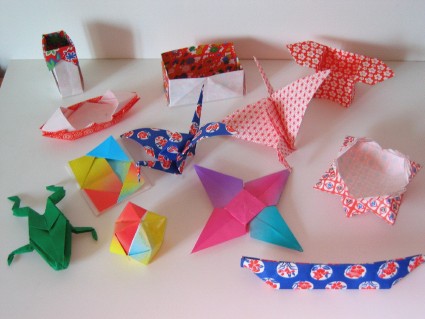

Flower Piker
Learn to cut paper
Back to the welcome page
First sheet
Previous sheet
Next sheet

|

Flower Piker |
|
Frequently Asked Questions Learn to cut paper Back to the welcome page First sheet Previous sheet Next sheet |
Learn to cut paper
| An important activity in the context of developing the autonomy of visually impaired people, paper cutting is frequently used in origami, in particular to obtain sheets of various shapes: squares, rectangles of a given ratio, convex polygons, regular polygons. The problem is frequently raised: how to obtain square sheets? In the vast majority of cases, this involves transforming an A4 sheet into a square. It is obvious that this operation necessarily leads to cutting the original sheet. Several methods are available, and it is very interesting to train blind people in one or other of the methods presented below. 1. manual cutting Very interesting method for developing the autonomy of blind people. In fact, it does not require any tools, and requires good control of your movements. The technique is simple (apparently): - Make a fold on the cutting line. Fold and refold this fold several times, in order to weaken the paper in this place. - place the sheet to be cut on a flat surface, the fold to be cut in the mountain position. - place both hands on the sheet, so that the thumbs touch and are on either side of the fold. The point where the two thumbs meet must be as close as possible to the start of the cut. - perform a rotation aimed at moving the thumbs apart from each other, rotating around the ends of the fingers. - when the cut (the tear) begins, progress little by little along the preparation fold until reaching the end of the cut. This technique gives good results with paper that is not too light (at least 80 g, Braille paper is ideal). In the case of a cut that is not at a right angle to the edge of the sheet, you must start (if possible) from the side presenting an angle as close as possible to the right angle. Leaving with an aided angle is very difficult. 2. cutting with a blade Several methods can be used, which may depend on the cutting tool: - scissors, - knife or small, sharp penknife, - cutter. It is possible that the best is to use the knife, the blade (quite thin and without notches) being slipped inside a flap. Scissors involve following a fold, which is certainly quite difficult. The cutter can be used like a knife, but its use is very delicate because the blade tends to cut crookedly. A first course of action consists of using a certain number of folds to determine the part to be removed: - by folding à 45° of a small edge onto a large one, the starting point being a vertex of the rectangle. We fold the rectangular flap along the edge that we have just folded (this is not very easy, because the extra thickness is very small). All you have to do is cut along the fold you have just made. - if we want to obtain a greater extra thickness, we start by folding at 45¡ a small edge over a large one, the starting point being a vertex of the rectangle. We unfold to be able to fold the opposite diagonal. We then fold the point thus obtained along the previous fold (be careful, you must transform a mountain fold into a valley fold). The bottom of the triangle thus obtained forms a horizontal line of thickness 3. We fold the rectangular flap along the extra thickness. All you have to do is cut along the fold you have just made. Final recommendation for using a knife or penknife: ensure that the blade is used in such a way that the cut is made by pulling the blade on the paper, and not by pushing it. It seems that blind people spontaneously adopt the second method, which leads to irregular cuttings. 3. cutting with a tool If you agree to use material aids, you can use a paper cutter, with all the precautions you can imagine. We can also imagine a device which allows the sheet to be cut to be blocked in a horizontal or vertical position in a square template. A groove system (or any other equivalent) then allows the excess paper to be removed. I proposed the plans for such a device in January 2005. A copy was made at the Institut des Hauts-Thbaudières and was tested by a blind person. I don't know what happened to it. |
| Contents | File |
| Help to obtain square sheets from an A4 sheet - M. Lucas | Bilan2004Ang.pdf |